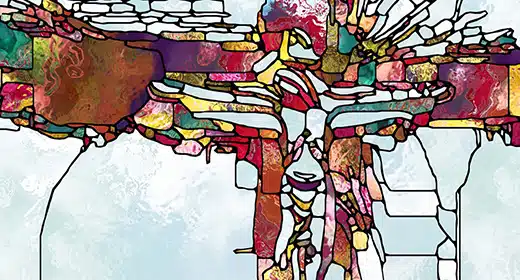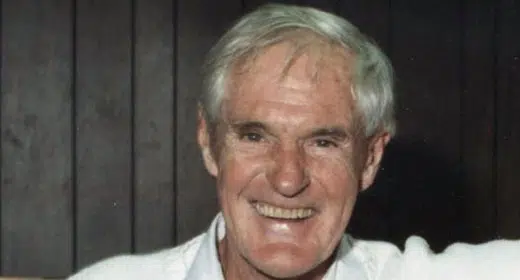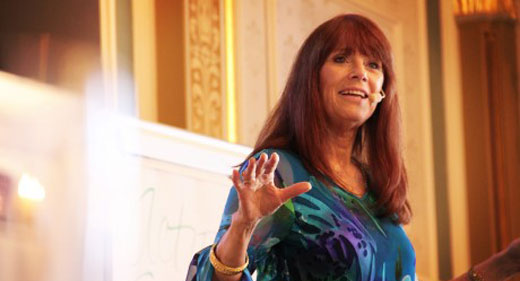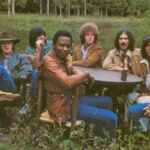by Laura Alden Kamm: Years ago while attending the Ohio State University I had to give a speech for a Sociology class. On the day of the event I entered the lecture hall with my thoughts securely in my mind and a black nylon bag slung over my shoulder.
 The class settled in. I stood silently—dead pan—in front of the group. In obvious display was the mysterious, lumpy bag stretched out on the table in front of me. My professor, seated in the back row, leaned forward and gave an approving nod.
The class settled in. I stood silently—dead pan—in front of the group. In obvious display was the mysterious, lumpy bag stretched out on the table in front of me. My professor, seated in the back row, leaned forward and gave an approving nod.
I stared. I stared at everyone just long enough to give rise to discomfort. I let edginess waft through the space a bit, and then began the slide presentation. Scenes of lotus flowers and children with puppies. War and stench. The Kent State University shootings and Gandhi. Peace and hate; murder and birth; order and chaos were all in the audience’s faces. I watched, as their expressive bodies shifted from ease and openness to rigidity and conflict with each click of the projector. “We face life every day. How we face it is always up to us”, I said.
Reaching into the bag, I whipped out a neon green and cherry-colored squirt gun. I pointed it at the ceiling. This was not just any ol’ gaudy squirt gun. It was a Super-soaker 200X. One tweak of the trigger and I could drench some innocent with a half gallon of water 25 feet away. And I demonstrated this awesome power as I yelled, “Stand up!” I showered the ceiling and walls with water to the shrieks of female students, covering their hair. The guys shouted back “YEAH!” My professor rolled into the aisle with laughter. (Luckily, it was a time in our culture when I could get away with this type of demonstration and not be tackled by security, having the whole thing end up on You Tube or reduced to Tweets.)
Under the persuasive power of compliance, I had them jumping on one foot, whistling and doing various other idiotic gestures. Compliance and the power of group think were keenly in my grasp. I put the squirt gun back in the bag and resumed my silence, waiting for them to make their own choice about what to do next. How long would it take them to release the group’s compliance to the perceived threat and newly established order? And how would they accomplish it?
It took nearly 20 minutes for my classmates to regain composure and find their individuality. Some kept standing, wide-eyed with anticipation for what could be next. What else could be in that black bag? A few appraised their clothing and belongings, making certain they were intact and not too wet. Some found their bearings. Fear washed over a few faces and their frozen bodies. Smiles and laughter echoed in the lecture hall, with chants of “How cool!” And, “Where can they get a squirt gun like that?” As the murmurs quieted it was palpable that they didn’t know what to do next. Kernels from that lecture are what I share with you this month.
These are challenging times for many people and their cultures. Uprisings, new horizons, celebrations, and war marbled with horror and precious moments of humanity helping humanity all poignantly weave life’s cloth of complexities. The pressure is on to change from the inside out. I do believe our world has the hiccups. Each one of us is charged with finding the places in our lives where we are being compliant, blindly following or being manipulated by a force that no longer serves us.
It’s hard to find who you are deep inside, having no map to which to cling for comfort or assurance. Compliance, usually an external force, causes you to over work, stay attached to the status quo, makes you do idiotic things and live a life that is not in your heart.
Ah, but compassion is on the inside. Compassion is the map. Compassion is the antidote to shock and its resulting compliance. Compassion is the way; no matter what is in your face in the moment. To be compassionate toward the tension of compliance—the tension arising from that to which you are attached and that with which you no longer resonate—is your path home. In those moments, if you can be present to that awareness, compassion will offer an opportunity to liberate your heart and your life.
Compassion is the art of giving your self a break and not being perfect in your life or spiritual pursuits. It is suave when you feel the need to be right or feel pushed by something else that says it’s right. Compassion for being you, just as you are, will set you free. Self-imposed compliance and rigidity are prisons. Rigidity is not discipline. Discipline is a nurturing and self-protective act that resonates with our deepest sense of self—your compassionate, true nature.
So I ask you, how will you be compassionate to yourself and others today? In what way will you give yourself space to be that which is truly in your heart—your service to this magnificent, chaotic and ever-changing world.
With love and compassion,
Laura








































